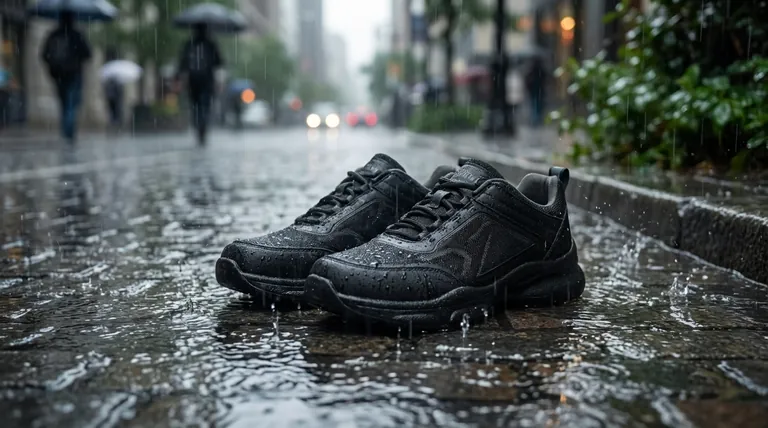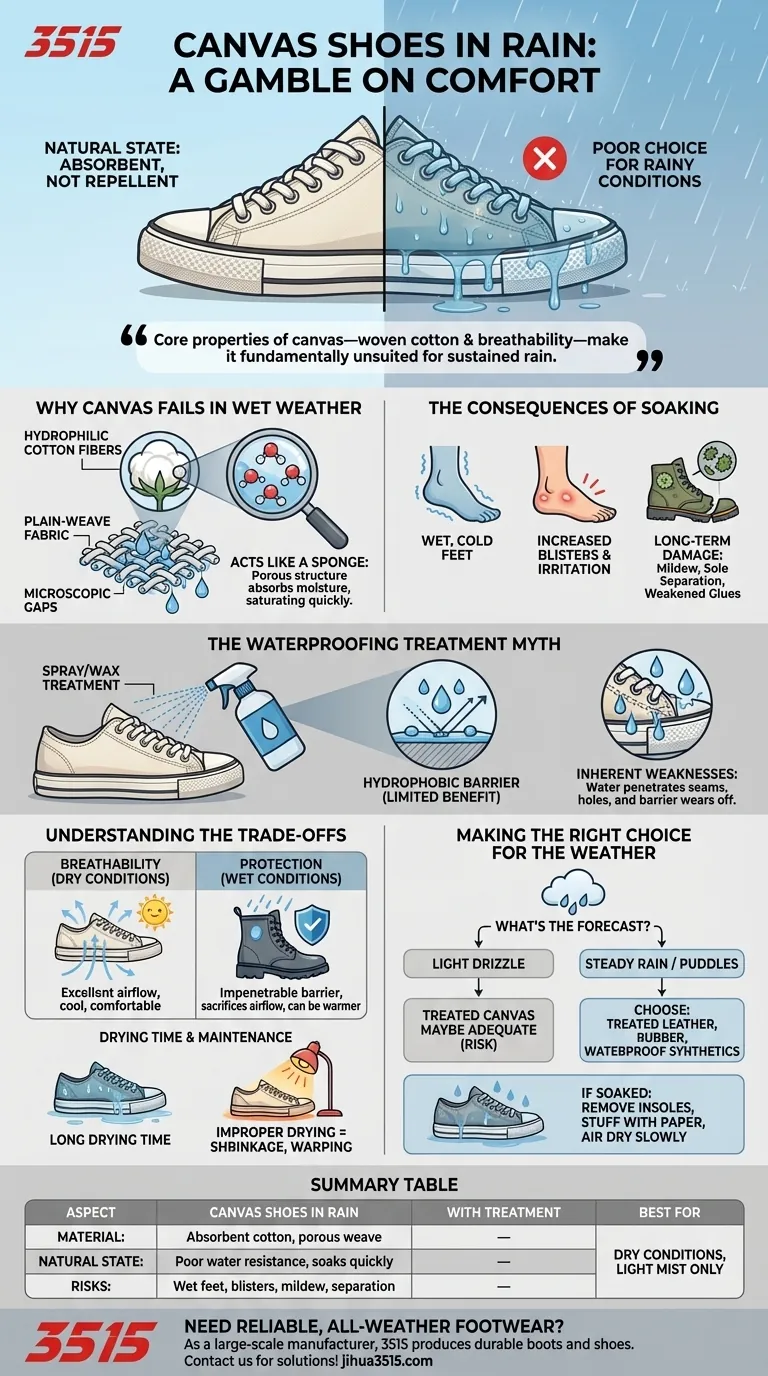In their natural state, canvas shoes are a poor choice for rainy conditions. The material is fundamentally absorbent, not repellent, meaning your feet will likely get wet, cold, and uncomfortable in anything more than a very light, brief drizzle.
While treatments can offer a minor degree of water resistance, the core properties of canvas—its woven cotton construction and breathability—make it fundamentally unsuited for sustained exposure to rain.

Why Canvas and Rain Don't Mix
To understand why canvas fails in wet weather, you must first understand the material itself. It's a choice made for breathability and comfort in dry conditions, not for protection from the elements.
The Nature of the Fabric
Canvas is a plain-weave fabric, typically made from cotton. Its structure is inherently porous, filled with microscopic gaps between the woven threads.
This design is excellent for allowing air to circulate, which keeps your feet cool and comfortable in warm weather.
High Absorbency
Cotton fibers are hydrophilic, meaning they naturally attract and absorb water molecules. When exposed to rain, canvas acts less like a shield and more like a sponge.
The material quickly becomes saturated, transferring moisture directly to your sock and foot.
The Consequences of Soaking
The immediate result of soaked canvas is discomfort. Wet feet lose heat rapidly, leading to a cold and unpleasant experience.
Furthermore, the friction from wet socks and shoes dramatically increases the likelihood of painful blisters and skin irritation.
Potential for Damage
Repeatedly soaking canvas shoes can cause long-term damage. Water can weaken the glues that bond the sole to the upper part of the shoe, causing them to separate.
If not dried properly and quickly, the damp fabric can also develop mildew, leading to discoloration and a persistent musty odor.
The Role of Waterproofing Treatments
Many people attempt to weatherproof their canvas shoes with sprays or waxes. While these can provide a limited benefit, it's critical to understand their limitations.
How Sprays and Waxes Work
Waterproofing products work by creating a thin, invisible hydrophobic barrier on the surface of the canvas fibers.
This coating encourages water to bead up and roll off rather than immediately soaking into the fabric.
The Level of Protection
This treatment provides water resistance, not true waterproofing. It can effectively handle a light mist or a few accidental splashes.
However, it will not withstand steady rain, walking through wet grass, or stepping in a puddle. The pressure and volume of water will quickly overwhelm the superficial barrier.
The Inherent Weaknesses
Even with treatment, water can still penetrate through seams, stitching holes, and around the metal eyelets for the laces. These areas are almost impossible to seal completely on a standard canvas shoe.
The protective coating also wears off with use and abrasion, requiring frequent reapplication to maintain any level of effectiveness.
Understanding the Trade-offs
The choice of footwear material always involves balancing competing properties. The very things that make canvas desirable in one context make it a liability in another.
Breathability vs. Protection
The primary advantage of canvas is its breathability. This same porosity is what makes it so vulnerable to water.
Truly waterproof footwear, like rubber boots or shoes with a GORE-TEX membrane, creates an impenetrable barrier to water but often sacrifices some of this airflow, which can lead to warmer, sweatier feet in dry conditions.
Drying Time and Maintenance
Once saturated, canvas holds onto moisture and can take a very long time to dry.
Improper drying, such as placing them too close to a direct heat source, can cause the fabric to shrink, warp, or become stiff, permanently altering the shoe's fit and comfort.
Making the Right Choice for the Weather
Ultimately, using canvas shoes in the rain is a gamble against comfort and the longevity of your footwear. A more strategic approach is to match your shoes to the forecast.
- If you're facing a light, brief drizzle: A well-treated pair of canvas shoes may be adequate for a short trip, but it's still a risk.
- If you expect steady rain or puddles: You should choose footwear made from inherently water-repellent materials like treated leather, rubber, or synthetics with a waterproof membrane.
- If your canvas shoes get soaked: Immediately remove them, take out the insoles, and stuff them tightly with newspaper or paper towels to absorb the internal moisture. Allow them to air dry slowly, away from direct heat.
Choosing the right footwear means understanding that a material's greatest strength in one scenario is often its greatest weakness in another.
Summary Table:
| Aspect | Canvas Shoes in Rain |
|---|---|
| Material | Absorbent cotton, porous weave |
| Natural State | Poor water resistance, soaks quickly |
| With Treatment | Limited water resistance, not waterproof |
| Risks | Wet feet, blisters, mildew, sole separation |
| Best For | Dry conditions, light mist only |
Need reliable, all-weather footwear? Don't let a rainy day ruin your comfort. As a large-scale manufacturer, 3515 produces a comprehensive range of durable boots and shoes designed for performance and protection. Whether you are a distributor, brand owner, or bulk client, we can deliver the right footwear solution for any condition. Contact us today to discuss your needs and elevate your product line!
Visual Guide

Related Products
- Wholesale Breathable Training Shoes Custom Athletic Footwear Manufacturer
- Wholesale Durable & Breathable Training Shoes for Custom Brands
- Lightweight Breathable Training Shoes for Wholesale & Custom OEM Manufacturing
- Wholesale Breathable & Cushioned Training Shoes Custom Factory Production
- Durable Canvas Work Shoes with Rubber Lug Sole | Wholesale Manufacturer
People Also Ask
- What should be considered when choosing smart trainers for business casual? A Guide to Professional Style
- How do athletic shoes with non-slip features differ from regular ones? Discover the Grip Advantage
- What are the benefits of breathable materials in work shoes? Enhance Comfort & Health for Your Workforce
- Why are running shoes and walking shoes not interchangeable? Avoid Injury with the Right Footwear
- What materials are best for athletic activities in warm climates? Stay Cool with Moisture-Wicking Fabrics



















